Reportable Medical Events, Military Health System Facilities, Week 22, Ending June 3, 2023
 Graph depicting the frequency of the five most common reportable medical events within the Military Health System over the preceding year.
Graph depicting the frequency of the five most common reportable medical events within the Military Health System over the preceding year.
Reportable Medical Events are documented in the Disease Reporting System internet by health care providers and public health officials across the Military Health System for the purpose of monitoring, controlling, and preventing the occurrence and spread of diseases of public health interest or readiness importance. These reports are reviewed by each service’s public health surveillance hub. The DRSi collects reports on over 70 different RMEs, including infectious and non-infectious conditions, outbreak reports, STI risk surveys, and tuberculosis contact investigation reports. A complete list of RMEs is available in the 2022 Armed Forces Reportable Medical Events Guidelines and Case Definitions.1 Data reported in these tables are considered provisional and do not represent conclusive evidence until case reports are fully validated.

Total active component cases reported per week are displayed for the top five RMEs for the previous year. Each month, the graph is updated with the top five RMEs, and is presented with the current month’s (May 2023) top five RMEs, which may differ from previous months. COVID-19 is excluded from these graphs due to changes in reporting/case definition updates in 2023.

References
- Armed Forces Health Surveillance Division. Armed Forces Reportable Medical Events. Accessed April 6, 2023. https://www.health.mil/Military-Health-Topics/Health-Readiness/AFHSD/Reports-and-Publications/Armed-Forces-Reportable-Medical-Events
- Defense Manpower Data Center. Department of Defense Active Duty Military Personnel by Rank/Grade of Service, October 31, 2022. https://dwp.dmdc.osd.mil/dwp/app/dod-data-reports/workforce-reports
- Defense Manpower Data Center. Armed Forces Strength Figures for January 31, 2023. https://dwp.dmdc.osd.mil/dwp/app/dod-data-reports/workforce-reports
- Navy Medicine. Surveillance and Reporting Tools–DRSI: Disease Reporting System Internet. https://www.med.navy.mil/Navy-Marine-Corps-Public-Health-Center/Preventive-Medicine/Program-and-Policy-Support/Disease-Surveillance/DRSI
You also may be interested in...
Article
Feb 7, 2025
Navy Medicine and Readiness Training Command Rota, Spain, is dedicated to fostering professional development and recruitment in military medicine.
Topic
Jan 31, 2025
Public Health supports the move from a health care system to a system of health by focusing on the prevention of disease, disability, and death in garrison and while deployed.
Article
Jan 7, 2025
The Environmental Protection Agency has designated January as National Radon Action Month, and the Centers for Disease Control and Prevention has chosen the last week of January as Radon Awareness Week. This is the perfect time to think about testing your home for radon.
Topic
Dec 23, 2024
The Medical Surveillance Monthly Report, a peer-reviewed journal launched in 1995, is the Armed Forces Health Surveillance Division's flagship publication. The MSMR provides monthly evidence-based estimates of the incidence, distribution, impact, and trends of health-related conditions among service members.
Topic
Dec 19, 2024
AFHSD established the Integrated Biosurveillance division to serve as a central biosurveillance coordination unit to meet the needs of Department of Defense medical and public health components and leadership.
Spotlight
Dec 12, 2024
overview of what types of innovation DHA is involved in.
Article
Dec 1, 2024
This report presents the rates of maternal syphilis among pregnant women and congenital syphilis among newborns in the Military Health System beneficiary population from 2012 to 2022. Between 2012 and 2021, cases of congenial syphilis in the U.S. increased by 755%, and rates of maternal and congenital syphilis within the Military Health System ...
Article
Dec 1, 2024
This study assessed the incidence and incidence rate ratio of selected kidney events among U.S. active component service members that occurred from 31 days to six months after a COVID-19 test. Early evidence suggests that COVID-19 is linked to kidney-related events in older and hospitalized patients but has not been examined among a younger, healthy ...
Article
Dec 1, 2024
Reportable medical events documented in the Disease Reporting System internet by health care providers and public health officials throughout the Military Health System are reported monthly in MSMR.
Article
Dec 1, 2024
This report summarizes the numbers, types, and rates of incident mental health disorder diagnoses among U.S. active component service members over a 5-year surveillance period, from 2019 through 2023, during which a total of 541,672 service members were diagnosed with at least one mental health disorder.
Report
Dec 1, 2024
 .PDF |
3.59 MB
.PDF |
3.59 MB
The December 2024 issue of MSMR, the Medical Surveillance Monthly Report
Article
Nov 14, 2024
The Defense Health Agency-Public Health Armed Forces Health Surveillance Division’s Global Emerging Infections Surveillance program partnered with the Centers for Disease Control and Prevention on the release of a global emerging infectious disease supplement for the November 2024 issue of Emerging Infectious Diseases.
Article
Nov 4, 2024
One of the challenges for Department of Defense public health experts in determining the impact of exposures on service members is identifying specific exposures and quantifying the exposure level that can lead to adverse health outcomes.
Article
Nov 1, 2024
This Surveillance Snapshot data suggest that modifications to the fitness training regimen may reduce bone stress injuries during basic cadet training at a military service academy.
Article
Nov 1, 2024
Severe bites by military working dogs can inflict significant medical and logistical burdens to operational units due to emergency evacuations, antibiotic treatments, and lost duty time.
You are leaving Health.mil
The appearance of hyperlinks does not constitute endorsement by the Department of Defense of non-U.S. Government sites or the information, products, or services contained therein. Although the Defense Health Agency may or may not use these sites as additional distribution channels for Department of Defense information, it does not exercise editorial control over all of the information that you may find at these locations. Such links are provided consistent with the stated purpose of this website.
You are leaving Health.mil
View the external links disclaimer.
Last Updated: August 24, 2023